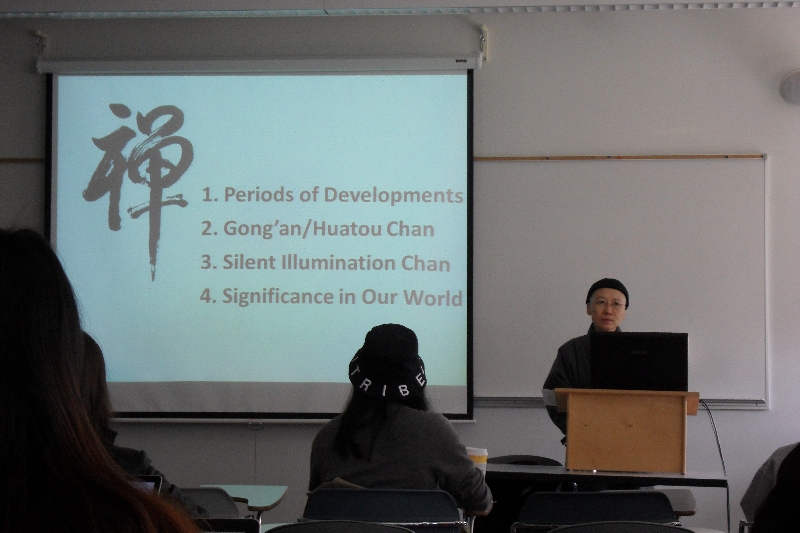Venerable Chang Wu’s lecture at University of British Columbia

In May of 2014, Ven. Chang Wu accepted an invitation from the University of British Columbia to attend a workshop on "Buddhist Perspectives on the Work of Care ". This year, on April 7th, she was invited back to give a one hour and 20 minute lecture to 50 students at the Institute of Asian Research. The topic of the lecture was "Introduction of Chan Buddhism and Its Practice Methods.”
This lecture was divided into three parts: "the origin and three periods of Chan Buddhism"; “the prevailing Chan practice methods, Huatou and Silent Illumination"; and "its relevance to our world today". Ven. Chang Wu encouraged the students not only to focus on the history or doctrine of Chan Buddhism but also to engage in its methods of practices. Not only is this the only way to have a full understanding of Chan, but meditation is useful and healthy in our stressful society.
Since its onset, Chan Buddhism has gone through many changes. Modern scholarship recognizes at least three periods:
Era of Pure Chan -- from Bodhidharma (d.534) through the sixth patriarch Huineng (d.713) During this period of almost two centuries, the Chan masters used sutras and teachings, following the traditional Buddhism terms and observing the spirit of Mahayana Buddhism to help others, not focusing on self- liberation only.
Era of Chan Practice in Wondrous Functions -- from Master Huineng through the end of the Tang dynasty (618-907): Five schools were established during this 250-year period, which was the peak time for Chan Buddhism. The teaching style became more elaborate. Other methods began to be used to enlighten students, including shouting, hitting, scolding, kicking, and contradictive phrases. Precepts, samadhi and prajna were not taught.
Era of Thorough Maturation -- after late Tang Dynasty: During this period of gradual decline, other methods of practice were adopted, such as reciting sutras, chanting Buddha’s name, prostrations and repentance practices. The “pure land” practice began to be promoted alongside meditation. There was more emphasis on looking into details instead of essences, and imitating the actions of ancient masters instead of working on practices to discover one’s self-nature and enlighten one’s mind.
In the Southern Song period, new Chan practices began to emerge: Gong’an, Huatou, and Silent Illumination. These represented an attempt to give new life to Chan Buddhism.
In the Buddha’s time, there was this sequential and gradual approach to practice, which is called "Four Dhyanas and Eight Samadhis"; however, this practice was not effective for the liberation of suffering. The Buddha developed another practice method called “Seven Expedients”. This method would also take a very long time to be effective, and needs to be practiced in a quiet place without distraction. This method is a step-by-step practice; in other words, it begins with practicing Samadhi and then gradually moves on cultivating Prajna.
Ven. Chang Wu contrasted these practices with the Sudden approach practice, which is one of the most distinctive practices of Chan Buddhism. This practice can be traced from Bodhidharma’s teaching of Two Entries and Four Practices, followed by the Third Patriarch Sengcan's Faith in Mind and the Sixth Patriarch Huineng's Platform Sutra, which contains the core tenet of Sudden Enlightenment, such as “the pure mind is the Buddha’s mind” and the “simultaneous practice of samadhi and prajna”.
Last but not least, Ven. Chang Wu used the practice method of "The samadhi of the single practice" in the Platform Sutra to point out that Chan is a way of living. It can be practiced in all activities in our daily lives, e.g. walking, eating, sitting, talking, doing laundry, etc. Everyone can practice Chan regardless of gender, age and health condition. A moment of peace in mind, that moment one is in a pure land. Pure land is not a remote place far away from our world, and peace is within us.